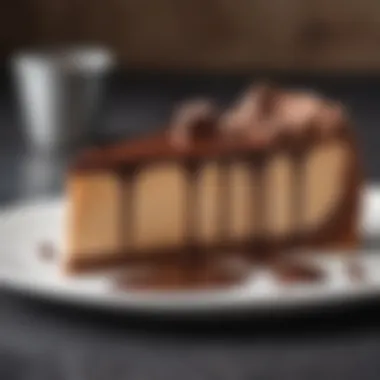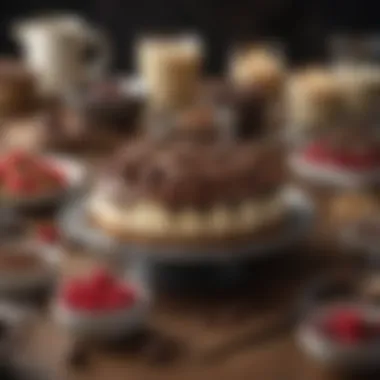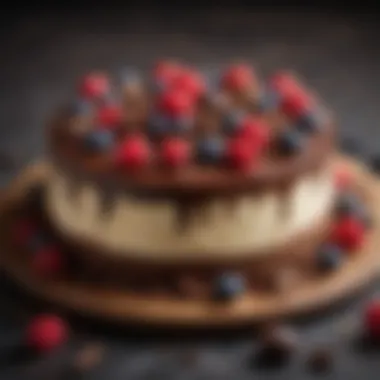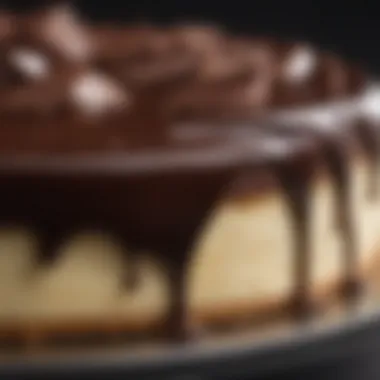Exploring the Depths of Chocolate Ganache Cheesecake


Recipe Overview
Chocolate ganache cheesecake is a luxurious dessert that combines the creaminess of cheesecake with the richness of chocolate ganache. This dessert has gained popularity for its decadence and is often the centerpiece of celebrations. The smooth harmonious blend of cream cheese and chocolate appeals to nearly every palate, making it a quintessential treat across various occasions.
The dessert typically features a dense, creamy filling that is topped with a glossy layer of chocolate ganache. The flavor profile has deep chocolate notes, complemented by a slight tang from the cream cheese. Because of its intricate preparation and rich flavors, chocolate ganache cheesecake is suitable for both novice bakers seeking to impress and experienced pastry chefs desiring a challenge.
Cuisine Type
Chocolate ganache cheesecake is predominantly categorized under American cuisine, but its elements can be traced back through various cultures that have embraced cheesecake and chocolate desserts. The technique of creating a ganache originates from French culinary practices, providing a fusion of flavors that many enjoy today.
Ingredients List
Detailed Ingredient Breakdown
To create a delicious chocolate ganache cheesecake, it is essential to use high-quality ingredients to achieve the best flavor and texture. Here’s a detailed breakdown of what you will need:
- Crust:
- Filling:
- Ganache Topping:
- Graham cracker crumbs
- Granulated sugar
- Unsalted butter
- Cream cheese
- Granulated sugar
- Eggs
- Heavy cream
- Cocoa powder
- Vanilla extract
- Dark chocolate (at least 60% cocoa)
- Heavy cream
Substitutions for Dietary Needs
Finding alternatives for certain dietary restrictions is possible without compromising the overall flavor. Here are a few common substitutions:
- Use gluten-free graham crackers for a gluten-free crust.
- Substitute dairy-free cream cheese for a vegan option.
- Opt for a sugar alternative like coconut sugar or a sugar substitute for a low-calorie variant.
- Use almond milk or coconut milk in place of heavy cream for non-dairy needs.
The beauty of chocolate ganache cheesecake lies in its adaptability. With thoughtful substitutions, even those with dietary restrictions can enjoy this delightful dessert.
This exploration into the key ingredients illustrates the essential components, emphasizing the need for quality and the versatility of the recipe. Moving forward, understanding the preparation method will shine a light on how to harmonize these ingredients to create the perfect chocolate ganache cheesecake.
Prelims to Chocolate Ganache Cheesecake
The world of chocolate ganache cheesecake represents a captivating fusion of flavors and textures. This dessert stands as a testament to culinary creativity, merging the rich decadence of chocolate with the creamy delight of traditional cheesecake. Understanding this unique mixture is essential for both novice bakers and seasoned pastry chefs, providing insight into the balance of ingredients and techniques that elevate it to a standout dish.
Defining Chocolate Ganache Cheesecake
Chocolate ganache cheesecake can be described as a layered dessert that typically combines a dense cheesecake base made from cream cheese, sugar, and eggs, topped with a smooth chocolate ganache. The ganache is prepared by heating heavy cream and pouring it over chopped chocolate, allowing it to melt and combine into a silky sauce. The result is a cheesecake that not only has the classic cheesecake characteristics but also an indulgently rich chocolate flavor.
This dessert can be served in various forms, including slices or individual tartlets, each showcasing the harmonious relationship between the chocolate and the creamy filling. Understanding its composition allows bakers to appreciate the complexities of flavor and texture that characterize chocolate ganache cheesecake.
The Allure of Chocolate and Cheesecake
The attraction to chocolate ganache cheesecake lies in its ability to satisfy multiple cravings simultaneously. Cheesecake is a favorite for its creamy and tangy qualities, while chocolate delivers a satisfying sweetness paired with depth of flavor. Together, they create a dessert that is not just about taste, but also about the experience of eating.
When chocolate is introduced into the already delightful cheesecake, it enhances the overall experience. It adds a depth that can transform a simple dessert into an exceptional one. This combination broadens the appeal, making it suitable for various occasions, whether it be a simple family gathering or an elegant dinner party.
The possibility for variations in recipes adds another layer of appeal. One can easily adapt the chocolate type, switch between dark, milk, or white chocolate according to personal preference. Chefs can infuse various flavors into the ganache or filling, creating endless opportunities for experimentation. The allure of chocolate ganache cheesecake lies not just in its flavor, but also in its versatility and the creativity it inspires in those who prepare it.
The History of Cheesecake
The history of cheesecake is a fascinating journey that not only illustrates the evolution of this dessert but also reflects cultural shifts and the creativity of baking throughout the ages. Understanding the origins and developments of cheesecake provides context for the chocolate ganache cheesecake we appreciate today. It traces back to ancient civilizations, adding to our appreciation of the layers of flavor and tradition in each slice. This exploration of cheesecake's past also highlights how recipes have transcended generations and geographical boundaries, informing the contemporary interpretations we enjoy.
Origin of Cheesecake
Cheesecake's origins are believed to reach as far back as ancient Greece. The first recorded mention of cheesecake can be traced back to the Greek physician Aegimus, around 230 AD, who wrote a book on the art of making cheesecakes. This early version used simple ingredients, primarily cheese, wheat flour, and honey. It was likely baked on heated stones. The Greeks served these early cheesecakes to athletes during the first Olympic games as a source of energy.
As the Greeks colonized regions of Europe, they brought their cheesecake recipe with them. The Romans later adopted and adapted it, often serving cheesecake at their feasts. This version frequently incorporated various flavors, expanding its appeal across the Roman empire. Through trade and conquest, cheesecake began to appear in various forms throughout Europe.
Evolution through the Ages
With time, cheesecake recipes evolved, influenced by local ingredients and culinary traditions. In medieval Europe, for example, cheesecakes gradually transformed as cream and eggs became more common. The introduction of cream in the 16th century created a richer, more decadent dessert. By this time, cheesecakes were becoming popular in England, often flavored with fruit or spices, showcasing the region's growing culinary focus.
The cheesecakes we know in modern times started to emerge in the 19th century with the invention of cream cheese in the United States. In 1872, a dairyman from New York discovered a method to create a soft, spreadable cheese, leading to the birth of what we recognize today as New York-style cheesecake. This version, characterized by its creamy consistency and dense texture, became a staple at gatherings and celebrations.
Additionally, the 20th century saw the combination of cheesecake with different flavors and textures, leading to the development of variations like the chocolate ganache cheesecake. Each new interpretation observed changes in societal tastes and preferences in dessert-making. Today, cheesecakes continue to evolve, embracing innovation while staying true to their rich heritage, making them a delightful representation of history on a plate.
"Cheesecake not only embodies indulgence but also connects us to our historical roots, reminding us of the culinary journeys taken by cultures around the globe."
Understanding Chocolate Ganache
Understanding the intricacies of chocolate ganache is crucial to mastering the art of chocolate ganache cheesecake. Ganache serves as the creamy heart of this dessert, binding flavors while enhancing texture. Its richness complements the lighter, tangy essence of the cheesecake, creating a balance that appeals to a wide range of palates. Additionally, knowing how to work with ganache allows bakers to make informed choices in recipe creation. It varies based on the type of chocolate used and its ratio to cream, impacting both taste and consistency.


Before diving deeper, it is essential to recognize that ganache can elevate a basic cheesecake into a gourmet experience. If not understood fully, the process of making ganache might lead to common pitfalls. Proper techniques in making ganache will ensure it integrates flawlessly into your cheesecake.
What is Ganache?
Ganache is a simple yet versatile mixture predominantly made from chocolate and heavy cream. When warm cream is poured over chopped chocolate, the heat melts the chocolate, creating a smooth and glossy blend. This combination is not just limited to desserts; it can also serve as icing or a filling for pastries. The heat from the cream helps emulsify the fats in chocolate, blending them seamlessly.
The texture of ganache can range from pourable to firm, depending on its intended use. For example, a thinner ganache can be poured over cakes, while a thicker variety can be whipped for a fluffy frosting.
Here are the key components of ganache:
- Chocolate: The quality and type directly influence the flavor. Dark, milk, and white chocolate all yield distinct results.
- Heavy Cream: This is essential for reaching that smooth consistency, with ratios varying for different textures.
- Flavorings: Although not necessary, additional flavors like vanilla, coffee, or liqueurs can enhance the ganache further.
Types of Ganache
Ganache can be categorized primarily based on the chocolate used and the ratio of cream to chocolate. Understanding these distinctions is vital for achieving the desired effect in your cheesecake. Here are the main types:
- Dark Chocolate Ganache: This variety typically contains a higher percentage of chocolate to cream. The result is rich and robust, often used for decadent desserts.
- Milk Chocolate Ganache: Containing less cocoa solids, this type is sweeter and creamier, making it a popular choice for those who prefer milder flavors.
- White Chocolate Ganache: Although technically not chocolate, white ganache relies on cocoa butter, offering a sweet and creamy profile, perfect for lighter cheesecakes.
- Flavored Ganache: By infusing the cream with different flavors, such as fresh herbs or citrus zests, bakers can create unique variations that add depth to their desserts.
Creating the right type of ganache involves understanding its properties and experimenting with different chocolate brands and methods.
"The beauty of ganache lies in its simplicity, yet its potential is limitless."
With a solid grasp of ganache and its variations, you can begin to explore how it integrates with the cheesecake structure. This knowledge will not only elevate your baking but also allow you to explore endless innovative options.
Key Ingredients
The selection of ingredients plays a crucial role in creating a successful chocolate ganache cheesecake. Each component adds unique properties that impact the flavor, texture, and overall experience of the dessert. Understanding these key ingredients helps achieve the desired quality and helps bakers customize their creations.
Cream Cheese: The Foundation
Cream cheese is the central element of chocolate ganache cheesecake. Its rich, smooth texture creates the base for the cheesecake filling. When selecting cream cheese, opt for full-fat varieties. They provide a creamier consistency and enhance the overall flavor of the cake.
Incorporating room temperature cream cheese into your recipe ensures smooth blending with other ingredients. Cold cream cheese can lead to lumps. Always whip the cream cheese until it's well combined before adding sugar and eggs. The end goal is a velvety filling that sets beautifully.
Chocolate: Selecting the Right Type
Chocolate is another vital component that defines the taste of the cheesecake. The choice between dark, milk, and semi-sweet chocolate can greatly affect the flavor profile. Dark chocolate, with a higher cocoa content, offers a rich, robust taste. In contrast, milk chocolate is sweeter and creamier, appealing to different palates.
When choosing chocolate, consider its quality. High-quality chocolate, such as brands like Ghirardelli or Callebaut, is often recommended for its superior flavors and smoother melting qualities. It is also important to use finely chopped chocolate or chocolate chips. This will ensure even melting when the ganache is prepared.
Sweeteners: Balancing Flavor and Texture
Sweeteners play a key role in balancing the flavors in a chocolate ganache cheesecake. The most common sweetener used is granulated sugar, but alternatives such as brown sugar can add depth to the flavor. Brown sugar introduces a hint of caramel, enriching the overall taste.
In addition to sugar, some bakers may prefer natural sweeteners like honey or maple syrup. These can impart unique flavors, but the sweetness level may need adjustments. It is essential to choose sweeteners that complement the chocolate and cream cheese without overwhelming them.
Always taste your filling mixture before baking. Adjust sweetness as needed to suit your palate.
The right blend of sweeteners ensures that the cheesecake is neither too sweet nor too bland. Ultimately, the balance of ingredients sets the stage for a delightful dessert.
Preparation Techniques
Understanding the preparation techniques for chocolate ganache cheesecake is crucial for achieving the desired texture and flavor. Each step in this process contributes to the overall quality of the dessert. The delicate balance of ingredients, their interactions during mixing, and the method of assembly all play pivotal roles. Mastering these techniques ensures that the cheesecake sets properly, remains creamy, and presents beautifully. Moreover, even minor deviations in technique can lead to significant changes in the final product.
Making the Crust
The crust is the foundation of a chocolate ganache cheesecake. Typically, a graham cracker crust is preferred, but options like Oreos or even almond flour provide unique flavors and textures. To make the perfect crust, crush the chosen cookies into fine crumbs. This can be done using a food processor or by placing them in a plastic bag and crushing them with a rolling pin.
Next, mix the crumbs with melted butter. This mixture should hold together when pressed. An even layer pressed firmly into the bottom of the pan allows for a sturdy base that supports the rich filling. Baking the crust briefly before adding the filling enhances its stability. This step is important as it also adds a slightly toasted flavor that complements the rich cheesecake.
Creating the Filling
The filling is where the magic happens. Combining cream cheese, sugar, and eggs is standard, but achieving the right consistency is vital. Start by softening the cream cheese. Cold cream cheese can lead to lumps and an uneven texture. Whip it until smooth before gradually adding sugar. Use both granulated and powdered sugar if desired; the latter tends to dissolve more easily.
Incorporating eggs one at a time helps maintain a smooth mixture. It is crucial to mix just until combined to avoid overmixing, which can introduce air and create cracks during baking. Adding melted chocolate is what transforms this cheesecake into a chocolate ganache cheesecake. When folding in chocolate, ensure it is slightly cooled to prevent it from seizing the mixture.
Assembling the Cheesecake
Once the crust and filling are prepared, it's time to assemble. Pour the creamy filling over the baked crust, ensuring it spreads evenly. Gently tap the pan on the counter to release any air bubbles. This prevents unsightly holes in the finished cheesecake. Using a spatula, smooth the top if needed.
Proper assembly is crucial for an even bake. Uneven surfaces may not set properly, leading to a fallible cheesecake. Adding a ganache layer on top after baking enhances both the flavor and aesthetic. This final step elevates the dessert, allowing flavors to meld, creating a cohesive treat.
Chilling and Setting
Once assembled, chilling is the key step in ensuring the cheesecake reaches the right consistency. Placing it in the refrigerator for several hours, or ideally overnight, allows the flavors to meld and the cheesecake to firm up. This time is essential. It allows the ganache to set beautifully on top of the cheesecake, creating a smooth finish.


Be mindful that cooling too quickly in a freezer can lead to cracks. One should cover the cheesecake with plastic wrap to prevent absorption of odors from the fridge. When ready to serve, allow the cheesecake to sit at room temperature for about 30 minutes for optimal texture. This striking balance of chilling, setting, and serving is what makes chocolate ganache cheesecake a pleasurable experience.
Baking Techniques
Baking techniques are a crucial aspect of creating a successful chocolate ganache cheesecake. The precision in method can impact texture, flavor, and overall appearance. Mastery of baking techniques allows bakers to interact effectively with the ingredients, enhancing the final product. By understanding various techniques, one can avoid common pitfalls like cracks on the surface or an inconsistent filling.
Water Bath Method
The water bath method, or bain-marie, is a popular technique for baking cheesecakes. It involves placing the cheesecake pan inside another larger pan filled with hot water. This approach provides gentle, even heat that helps maintain moisture in the cheesecake.
Using a water bath can significantly reduce the risk of cracks. The steam created in the baking process prevents the cheesecake from drying out. This method, however, requires careful preparation. It is essential to wrap the cheesecake pan tightly in aluminum foil to prevent water from leaking in.
Here are a few steps to effectively implement the water bath method:
- Prepare your cheesecake batter and crust as desired.
- Wrap the bottom and sides of the springform pan with aluminum foil.
- Place the wrapped pan inside a larger roasting pan.
- Pour hot water into the roasting pan, filling it until it reaches about halfway up the sides of the cheesecake pan.
- Bake as directed, ensuring that the water remains hot during the entire baking time.
Time and Temperature Considerations
Time and temperature are two elements that determine the texture and doneness of a cheesecake. The right temperature helps achieve a creamy consistency without overbaking. Cheesecakes generally bake at lower temperatures, often ranging between 325 to 350 degrees Fahrenheit. Over baking can lead to a dense and dry product.
Every oven can behave differently, thus, it is advisable to monitor the cheesecake closely as it nears completion. A cheesecake is typically done when the edges appear set, while the center remains slightly jiggly. This indicates that the cheesecake will firm up upon cooling.
Consider a few additional tips for managing time and temperature:
- Use an oven thermometer to ensure accurate temperatures.
- Make note of your baking time, adjusting it if necessary based on the specific characteristics of your oven.
- Allow the cheesecake to cool gradually. Rapid temperature changes can cause cracks. After baking, turn off the oven, leave the door slightly ajar, and let the cheesecake sit for an hour before removing.
Baking techniques like the water bath and attentiveness to time and temperature are essential for achieving a perfect chocolate ganache cheesecake. Understanding these practices ensures a delightful end product that is both visually appealing and delicious.
Common Mistakes and How to Avoid Them
When navigating the art of baking, understanding common mistakes can save both time and ingredients. The process of making a chocolate ganache cheesecake is intricate, and small missteps can lead to disappointing results. Recognizing these pitfalls is crucial for achieving a successful cake. Below are specific issues to be aware of, alongside solutions to ensure that your cheesecake is rich, smooth, and perfectly texturized.
Overmixing vs. Undermixing
In the context of preparing the cheesecake filling, mixing plays a pivotal role. Overmixing incorporates too much air, leading to a cheesecake that rises excessively during baking and then collapses as it cools. This results in a dense and often unappetizing texture. To avoid this, aim for a smooth consistency without beating vigorously.
On the contrary, undermixing is equally problematic. If the ingredients are not combined well enough, lumps of cream cheese, sugar, or chocolate may remain, impacting the final product. This can also lead to an uneven bake.
To strike a balance, mix the ingredients until just combined, using a spatula or mixer on low speed. A well-blended mixture is essential, but it should not be overworked. Aim for a filling that is uniform and creamy without visible chunks.
Identifying Overbaking
Baking times are crucial for the perfect chocolate ganache cheesecake. Overbaking can cause the surface to crack and the texture to become dry. It might be tempting to allow the cheesecake to bake for longer under the impression that it will ensure doneness. However, cheesecakes continue to cook even after being removed from the oven due to residual heat.
A good indicator of doneness is the jiggle test. When the cheesecake is gently shaken, it should wobble softly in the center. If it appears too liquid, it may need more time, but if it looks set, it’s usually ready.
In addition to monitoring jiggle, check for a slight golden hue around the edges. This visual cue suggests that the outer areas are properly baked, contributing to a contrasting texture. Use a thermometer if necessary. The internal temperature for a cheesecake tends to be around 150°F (65°C).
By avoiding overbaking, you maintain the rich creaminess that characterizes a good cheesecake. Ensuring that you pull the cake from the oven at the right time will enhance overall flavor and texture.
"Baking is a science, and understanding the critical elements can make all the difference."
In summary, by paying attention to mixing techniques and baking times, you can effectively sidestep common mistakes and achieve a chocolate ganache cheesecake that is both indulgent and satisfying.
Creative Variations
Creative variations in chocolate ganache cheesecake provide an exciting avenue for bakers to explore their culinary creativity. By modifying flavors, ingredient options, and presentation styles, individuals can create desserts that reflect personal preferences or seasonal inspirations. Each variation can elevate the cheesecake, allowing for unique taste experiences. Importantly, these adaptations can also cater to dietary restrictions or health considerations, making the dessert more accessible.
Adding Flavors: From Caramel to Coffee
Incorporating additional flavors is one of the simplest ways to innovate chocolate ganache cheesecake. Common flavor additions include caramel, which offers a rich, buttery sweetness that balances the dense chocolate. To achieve this, consider drizzling a layer of caramel sauce on top before chilling. Alternatively, you can fold caramel chunks into the filling itself for a more integrated taste.
Coffee is another popular flavor enhancer. Its bitter notes can contrast beautifully with the sweet chocolate, creating a more complex profile. One effective method is to use brewed espresso or coffee extract in the ganache. Just a small amount can significantly elevate the overall flavor without overwhelming the primary chocolate taste. For those fond of adventurous palates, consider exploring exotic flavors such as orange zest or peppermint to bring a refreshing twist.
Healthier Alternatives for Ingredients
Health consciousness is increasingly influencing baking decisions. Fortunately, chocolate ganache cheesecake can be modified to fit healthier lifestyles without sacrificing flavor. For the crust, consider using almond flour or oats instead of traditional graham crackers. These alternatives provide a nutty flavor and can add nutritional benefits, such as more fiber and protein.
In the filling, opt for low-fat cream cheese or Greek yogurt to reduce calories while maintaining a creamy texture. For sweetness, natural sweeteners like agave nectar or maple syrup can replace refined sugars. Additionally, using dark chocolate with a high cocoa content can enhance the health aspects due to its lower sugar content and higher antioxidants. Such choices allow for a delicious dessert that aligns with dietary goals.
Mini Cheesecakes vs. Traditional
The debate between mini cheesecakes and traditional large versions offers an interesting dynamic in dessert preparation. Mini cheesecakes are ideal for portion control, making them suitable for gatherings or events. They can also be visually appealing, presenting a delightful option for serving at parties. Most importantly, they provide a chance to experiment with various toppings or flavors in one baking session. This approach can cater to a greater variety of tastes among guests.
Conversely, traditional cheesecakes serve as a centerpiece for celebrations. Their size allows for a more intense flavor experience per slice, and they can be more rewarding in terms of presentation when served whole. While baking times and techniques are slightly different, both types offer unique benefits. Therefore, the choice between them comes down to personal preference and the context of the occasion.


"Creative variations in desserts allow bakers to express their individuality while catering to diverse tastes and dietary needs."
Serving Suggestions
In the realm of desserts, serving suggestions play a pivotal role in enhancing the overall experience of a dish, and chocolate ganache cheesecake proves no exception. This section emphasizes the significance of thoughtful pairing and presentation, allowing the cheesecake to shine while complementing its rich flavors.
Pairing with Beverages
The right beverage can elevate the taste of chocolate ganache cheesecake. When choosing a drink, one should consider the rich, creamy nature of the cake. Here are some excellent options:
- Red Wine: A full-bodied red like Cabernet Sauvignon can enhance the chocolate notes, providing a balance of sweetness and tartness.
- Coffee: The bitterness of black coffee perfectly contrasts the sweetness of the cheesecake, creating a harmonious pairing.
- Dessert Wines: Opt for sweet dessert wines like Sauternes or Late Harvest Riesling for those wishing to enhance sweetness.
- Tea: A strong herbal tea, like chai, brings warm spices that can pair nicely with chocolate.
These beverages work not only to complement flavors but also to cleanse the palate between bites, enhancing the overall tasting experience.
Garnishing Ideas
Presentation adds appeal, making the chocolate ganache cheesecake more enticing. Here are wooden ideas for garnishing:
- Chocolate Shavings: Simple yet effective, sprinkle dark or white chocolate shavings on top for a visual layer.
- Fruits: Fresh raspberries or strawberries can bring a bright contrast to the dark chocolate, also adding a tartness that balances richness.
- Whipped Cream: A dollop of lightly sweetened whipped cream on the side can provide a creamy texture that enhances the experience.
- Nuts: Crushed hazelnuts or almonds can add a nice crunch, introducing another texture to the dessert.
The key to garnishing is to keep it simple. Too many elements can distract from the cheesecake's rich flavors.
Storage and Shelf Life
Understanding the proper storage and shelf life of chocolate ganache cheesecake is crucial for maintaining its quality and flavor. This dessert, known for its rich texture and decadent taste, can easily be affected by improper storage methods. Without appropriate care, the cheesecake may lose its freshness, texture, and overall appeal. Moreover, knowing the shelf life of the cheesecake helps in planning and preventing waste, ensuring that you can enjoy this indulgent treat at its best.
Best Practices for Storage
To maximize the shelf life and quality of chocolate ganache cheesecake, follow these best practices:
- Refrigeration: Always store the cheesecake in the refrigerator. Cover it tightly with plastic wrap or place it in an airtight container to prevent it from absorbing odors from other foods.
- Avoid Unnecessary Exposure: Limit the cheesecake's exposure to air by covering it properly. Each time it is removed, condensation can form, affecting its texture.
- Slice Just Before Serving: If possible, keep the cheesecake whole until you are ready to serve. Slicing exposes more surface area, which can lead to drying out.
- Use a Clean Utensil: When cutting the cheesecake, use a clean knife to prevent contamination and to maintain the freshness of the remaining pieces.
- Freezing for Long-Term Storage: If you need to store the cheesecake for an extended period, consider freezing it. Wrap individual slices or the whole cheesecake in plastic wrap, followed by aluminum foil to prevent freezer burn. Label with the date to keep track of how long it’s been stored.
Understanding Shelf Life
The shelf life of chocolate ganache cheesecake depends on several factors, including ingredients and storage conditions. Here's a general guide:
- Refrigerated Cheesecake: When stored properly in the refrigerator, chocolate ganache cheesecake can last about 5 to 7 days. After this period, it may still be safe to eat, but the texture and taste may start to deteriorate.
- Frozen Cheesecake: If you choose to freeze the cheesecake, it can last for up to 3 months. To maintain optimal taste and texture, it is best to consume it within this time frame.
- Signs of Spoilage: Always check for signs of spoilage before consumption. Common indicators include off smells, changes in texture, or mold. If any of these are present, it’s better to discard the cheesecake to ensure food safety.
Proper storage not only preserves the cheesecake's flavor, but it also enhances your overall baking experience by allowing you to enjoy the dessert over time.
Cultural Significance of Cheesecake
The cultural significance of cheesecake is broad and varied, reflecting the complex interplay of history, culinary art, and social customs. Cheesecake is not just a dessert; it embodies traditions and preferences from around the world. Understanding its cultural role helps to appreciate the diversity of its flavors and styles.
In many cultures, cheesecake is seen as a symbol of celebration. Birthdays, weddings, and holidays often feature this dessert. Its rich, creamy texture and decadent flavors make it a favored choice for special occasions. Over the decades, regional variations have emerged, each infusing local ingredients and flavors into the core recipe, enhancing its significance in respective cultures.
Cheesecake in Global Cuisines
Cheesecake has transcended borders, becoming a beloved dessert in numerous countries. From the New York-style cheesecake that is rich and dense, to the Italian ricotta cheesecake, which tends to be lighter and fluffier, each variant tells a story.
- New York-style cheesecake: Characterized by its creamy texture, this version uses cream cheese as the primary ingredient, often topped with fruit or chocolate ganache.
- Italian ricotta cheesecake: Lighter and less sweet, this cake often incorporates ricotta cheese, presenting an alternative flavor profile rich in tradition.
- Japanese cotton cheesecake: Known for its airy, fluffy nature, this variant uses meringue and is baked at a low temperature for a light consistency.
Each of these varieties showcases the ingredient preferences and culinary influences that shape a region’s tastes, indicating how cheesecake adapts to cultural norms.
Celebrating with Cheesecake: Traditions
Different cultures celebrate with cheesecake in unique ways, illustrating its significance in societal rituals. In the United States, for instance, it might be common to serve cheesecake at a birthday party or holiday gathering. On the contrary, in Greece, cheesecake, usually made with fresh cheese and honey, is part of traditional feasts and celebrations.
In Poland, a version called "Sernik" is often served during major religious holidays, demonstrating its importance within community and family gatherings.
"Cheesecake is not just food; it is a way to celebrate life’s moments, big and small."
Likewise, Jewish traditions often include cheesecake during the Shavuot holiday, marking the dairy-rich meals that honor the festival's themes. This illustrates how cheesecakes, especially those flavored with citrus or topped with berries, have become interwoven into the fabric of cultural celebrations.
The diverse ways in which cheesecake is prepared and enjoyed underscore its role as a cultural artifact. Through these varying customs, it is evident that cheesecake is more than just a dish. It is a symbol of community, family ties, and the sweet moments in life.
Closure
The significance of concluding our exploration on chocolate ganache cheesecake lies in its ability to encapsulate the essence of this rich and versatile dessert. It serves as a reminder of not only the process involved in creating this indulgence but also the cultural importance surrounding it. As we summarize the insights presented throughout this article, we recognize the importance of each ingredient and stage in the baking process. Adequately understanding these elements carries benefits that extend beyond mere baking, fostering a deeper connection to the culinary art.
The Timeless Appeal of Chocolate Ganache Cheesecake
Chocolate ganache cheesecake possesses a timeless appeal for various reasons. First, it combines two beloved desserts: the rich softness of cheesecake paired with the luxurious texture of chocolate ganache. This union creates a dessert that is both satisfying and sophisticated. Furthermore, the adaptability of the recipe allows for personal expression in the kitchen.
The allure also stems from its presence in celebratory settings. Whether serving it during holidays, milestones, or casual gatherings, chocolate ganache cheesecake brings joyous moments. Each slice serves not just as a treat, but also as a focal point around which celebrations can revolve. The simplicity of its presentation, along with the complexity of flavors, invites admiration from food lovers.
Encouraging Innovation in Baking
Encouraging innovation in baking is essential for growth and enjoyment within this culinary field. Chocolate ganache cheesecake specifically offers numerous pathways for creative expression. From the selection of chocolate to the incorporation of unique flavors like matcha or berry swirls, each baker has the opportunity to leave a personal mark.
Moreover, experimenting with healthier alternatives can enhance accessibility. Options such as low-fat cream cheese or sugar substitutes do not diminish the taste when used skillfully. This opens the door for bakers to accommodate dietary restrictions and varying preferences.
In essence, presenting variations and encouraging experimentation not only enriches the baking experience. It also brings more people to join in creating this cherished dessert, fostering community through shared love of food.















